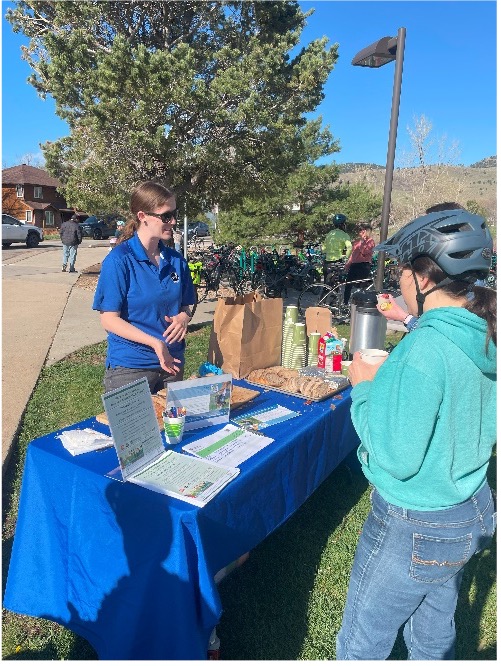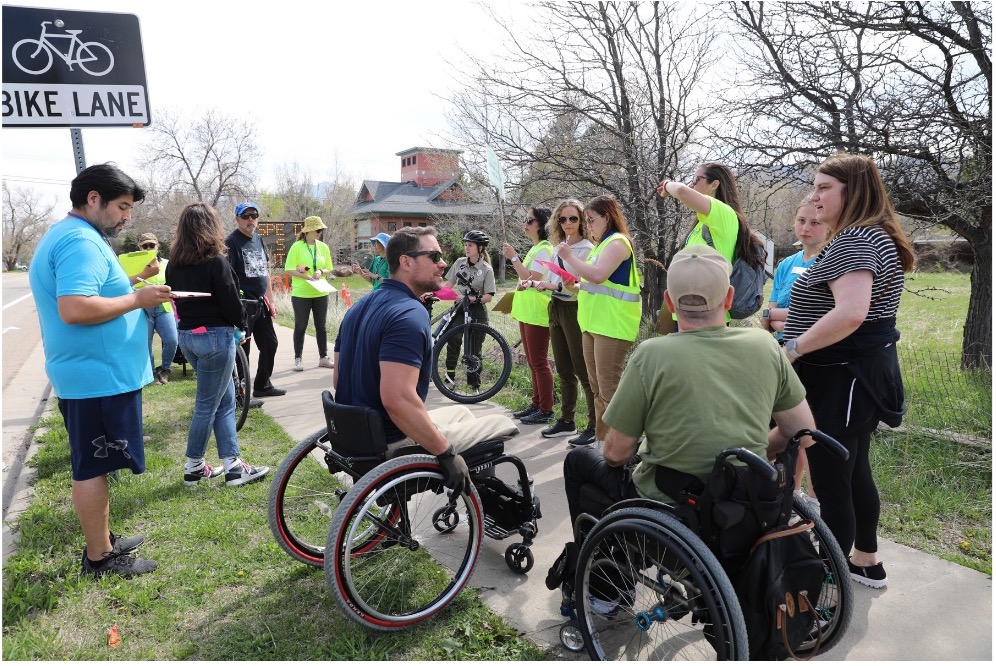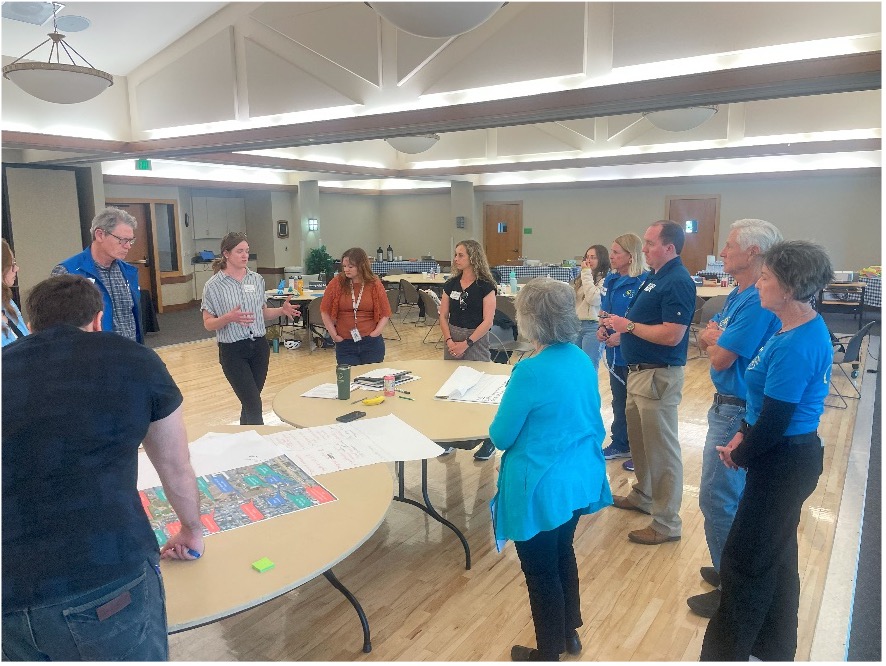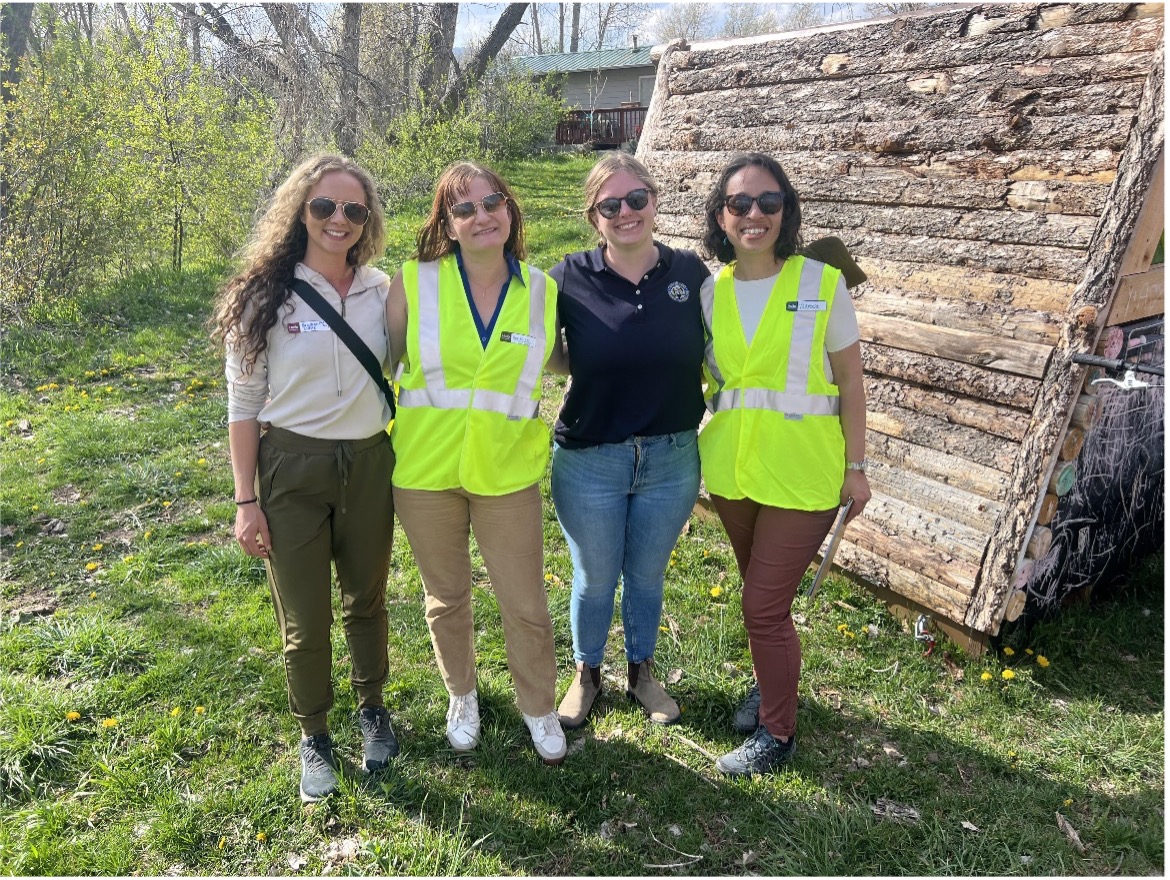At the end of April, we had a chance to visit two of the four Colorado communities participating in our 2024 Safe Routes to Parks Activating Communities program. For the last four months, each community has hosted engagement activities, surveyed residents, and collected data to inform community goals on improving local park access. The in-person site visits and Safe Routes to Parks workshops convene local partners to collaborate on opportunities, solutions, and resources that can help advance those goals. These site visits also enrich our own perspective, reinforcing lessons that can apply to any community working on improving biking, walking, and rolling. Here are a few nuggets of wisdom worth elevating from our recent visits to Boulder and Wheat Ridge.
Safe Routes to Schools + Parks are a powerful duo. Partner up to diversify engagement, inform route improvements, and host community programs.

Figure 1 City of Boulder Parks and Recreation staff, Charlotte O'Donnell engages families about the new park on Violet Avenue and Safe Routes to Parks improvements during Crest View Elementary’s Bike to School Day. Photo credit: City of Boulder, Jonathan Thorton
Safe Routes to School and Safe Routes to Parks are natural partners. Not only do nearby schools often benefit from park access improvements, partnering up also has the added benefit of opportunities to engaging families and youth, collaborating with schools to organize programs in the park, and even working together to apply for grant funding. In both communities we visited, schools have become a key partner in advancing Safe Routes to Parks initiatives.
For instance, in Wheat Ridge, parks staff along with non-profit partners, Bike Jeffco and Wheat Ridge Active Transportation Advisory Team realized right away that nearby schools would benefit from improvements to two of their most well-used parks – Crown Hill Park and Fruitdale Park. With two elementary schools and the city high school located along these routes to the parks, it was clear that slowing down cars, improving crossings, and adding elements like sidewalks and bike lanes would invariably benefit youth traveling to school as well. School representatives and parents attended Wheat Ridge’s Safe Routes to Parks workshop.
They reinforced goals for specific park access improvements and offered opportunities to partner with the school communities. The coalition is excited about plans to activate routes near the parks and schools, partnering with the school communities to install colorful crosswalks and pop-up improvements in time for Fall back-to-school.
Walk audits are valuable tools to understand the diverse mobility needs, especially for youth, older adults, and people with disabilities.
There are a lot of ways to collect community input on park access, and one of our favorite tools is the Safe Routes to Parks walk audit. The value of this activity continues to be reinforced by communities voicing the value of the in-person, on-the-ground experience to walk or roll routes to illuminate community needs and facilitate conversations with community members.
During Boulder’s Safe Routes to Parks workshop, PLAY Boulder and the City of Boulder Parks and Recreation organized a Roll ‘N Stroll Audit to assess current route conditions and build awareness of the needs of people with disability in getting to the city’s first accessible park. As part of the audit, partners with lived experience of having a disability led an accessibility activity and invited participants to borrow a wheelchair or low-vision googles to get to the park. While a temporary experience does not compare to or replace the feedback from someone actually living that experience, the activity deepened understanding and provoked thoughtful dialogue. Even though the park was only a short distance, community members using the borrowed wheel chairs and low-vision googles underscored the challenge of crossing a busy street and traveling along narrow, uneven sidewalks. Though the condition was short-lived for some participants, the experience highlighted the significance of route improvements to ensure that access would not be a barrier to visiting the future park on Violet Avenue.

Figure 2 Boulder’s Roll ‘n Stroll Audit from Crestview Elementary to the future park on Violet Avenue with neighbors, partners, and the City of Boulder. Topher Downham from the City of Boulder Open Space & Mountain Park leads an accessibility activity with the group. Photo credit: City of Boulder, Jonathan Thornton
Prioritize and partner up for active transportation funding!
During their Safe Routes to Parks workshop and with partners literally gathered around the table, each community seized the opportunity to move their actions into reality by making moves to apply for active transportation funds. With the historic influx of funding for biking and walking available now and Safe Streets and Roads for All grant application still open, communities felt motivated to take advantage of these resources. As partners took stock of their project goals and started to break those down into smaller actionable steps, it became clearer that phasing projects would make them feel more doable and funding applications straightforward.
In Boulder, partners in Transportation and Mobility Department who also participated in their Roll ‘n Stroll Audit committed to moving forward a funding request for a Colorado’s Safe Routes to School grant this Fall to construct a sidewalk segment that would improve the future park and school connection. In Wheat Ridge, with support and encouragement from their metropolitan planning organization, community partners along with city staff started to draft a proposal to submit for a Safe Streets and Roads for All grant. By the end of the workshop, they had a solid outline and content for their grant submission!

Figure 3 During their Safe Routes to Parks workshop, partners in Wheat Ridge worked together to identify a Safe Streets and Roads for All proposal
We’re incredibly proud of these Safe Routes to Parks community as they worked to build community connections, grow support for active transportation, and moved their plans into actions.
Special thanks to Colorado’s Safe Routes to Parks state team!
We want to give a special shout-out to Colorado partners – Colorado Department of Public Health and the Environment, Department of Transportation, and Department of Parks and Wildlife who were active participants in both workshops and site visits. Their expertise and resources were clearly a key part in making these workshops a success!

Figure 4 From left to right: Bradyn Nicholson, CDPHE, Annelies Van Vonno, CDOT, Izzy Petersen, CPW, Vanessa Cascio, SRP

